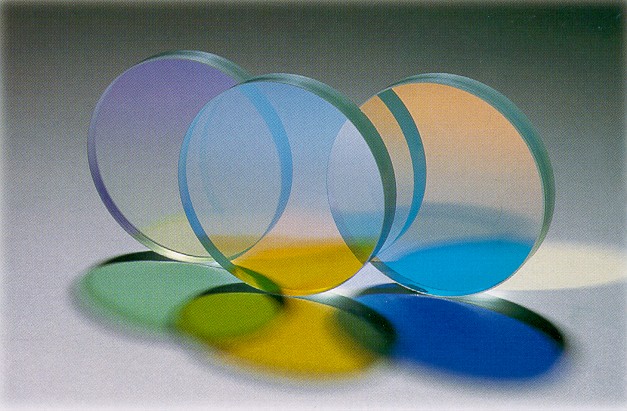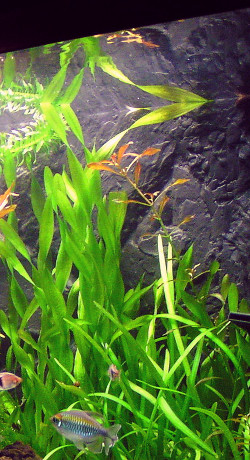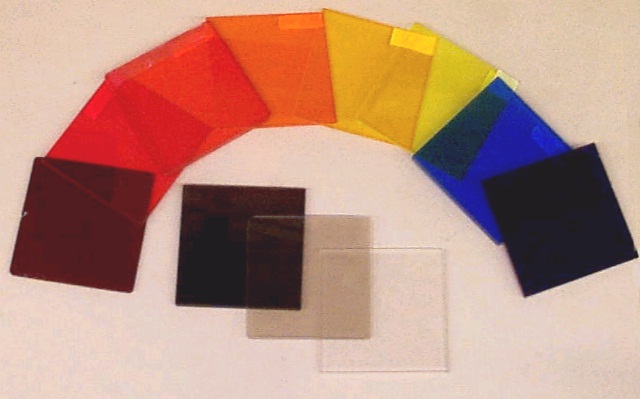|
Dichroic Prism
A dichroic prism is a prism (optics), prism that splits light into two beams of differing wavelength, wavelengths (colour). A trichroic prism assembly combines two dichroic prisms to split an image into 3 colours, typically as red, green and blue of the RGB colour model. They are usually constructed of one or more glass prisms with dichroism, dichroic optical coatings that selectively reflect or transmit light depending on the light's wavelength. That is, certain surfaces within the prism act as dichroic filters. These are used as beam splitters in many optical instruments. (See: Dichroism, for the etymology of the term.) Applications in camcorders or digital cameras One common application of dichroic prisms is in some camcorders and high-quality digital cameras. A ''trichroic prism assembly'' is a combination of two dichroic prisms which are used to split an image into red, green, and blue components, which can be separately detected on three charge-coupled device, CCD arrays. ... [...More Info...] [...Related Items...] OR: [Wikipedia] [Google] [Baidu] |
Digital Camera
A digital camera, also called a digicam, is a camera that captures photographs in Digital data storage, digital memory. Most cameras produced today are digital, largely replacing those that capture images on photographic film or film stock. Digital cameras are now widely incorporated into mobile devices like smartphones with the same or more capabilities and features of dedicated cameras. High-end, high-definition dedicated cameras are still commonly used by professionals and those who desire to take higher-quality photographs. Digital and digital movie cameras share an optical system, typically using a Camera lens, lens with a variable Diaphragm (optics), diaphragm to focus light onto an image pickup device. The diaphragm and Shutter (photography), shutter admit a controlled amount of light to the image, just as with film, but the image pickup device is electronic rather than chemical. However, unlike film cameras, digital cameras can display images on a screen immediately afte ... [...More Info...] [...Related Items...] OR: [Wikipedia] [Google] [Baidu] |
Three-CCD Camera
A three-CCD (3CCD) camera is a camera whose imaging system uses three separate charge-coupled devices (CCDs), each one receiving filtered red, green, or blue color ranges. Light coming in from the lens is split by a beam-splitter prism into three beams, which are then filtered to produce colored light in three color ranges or "bands". The system is employed by high quality still cameras, telecine systems, professional video cameras and some prosumer video cameras. Overview Compared to cameras with only one CCD, three-CCD cameras generally provide superior image quality by using full-frame dichroic filters to better separate the red, green and blue color bands, and better low-light performance. By separating red, green, and blue color ranges with a 1:1 pixel ratio (known as "4:4:4"), three-CCD cameras achieve much better precision than single-CCD cameras. In contrast, almost all single-CCD cameras use a Bayer filter A Bayer filter mosaic is a color filter array (CFA) f ... [...More Info...] [...Related Items...] OR: [Wikipedia] [Google] [Baidu] |
Thin-film Optics
Thin-film optics is the branch of optics that deals with very thin structured layers of different materials. In order to exhibit thin-film optics, the thickness of the layers of material must be similar to the coherence length; for visible light it is most often observed between 200 and 1000 nm of thickness. Layers at this scale can have remarkable reflective properties due to light wave interference and the difference in refractive index between the layers, the air, and the substrate. These effects alter the way the optic reflects and transmits light. This effect, known as thin-film interference, is observable in soap bubbles and oil slicks. More general periodic structures, not limited to planar layers, exhibit structural coloration with more complex dependence on angle, and are known as photonic crystals. In manufacturing, thin film layers can be achieved through the deposition of one or more thin layers of material onto a substrate (usually glass). This is most ... [...More Info...] [...Related Items...] OR: [Wikipedia] [Google] [Baidu] |
Polarizer
A polarizer or polariser is an optical filter that lets light waves of a specific polarization (waves), polarization pass through while attenuation, blocking light waves of other polarizations. It can filter a beam of light of undefined or mixed polarization into a beam of well-defined polarization, known as polarized light. Polarizers are used in many optics, optical techniques and optical instrument, instruments. Polarizers find applications in photography and liquid crystal display, LCD technology. In photography, a polarizing filter (photography), polarizing filter can be used to filter out reflections. The common types of polarizers are linear polarizers and circular polarizers. Polarizers can also be made for other types of electromagnetic waves besides visible light, such as radio waves, microwaves, and X-rays. Linear polarizers ''Linear polarizers'' can be divided into two general categories: absorptive polarizers, where the unwanted polarization states are absorption ... [...More Info...] [...Related Items...] OR: [Wikipedia] [Google] [Baidu] |
Numerical Aperture
In optics, the numerical aperture (NA) of an optical system is a dimensionless number that characterizes the range of angles over which the system can accept or emit light. By incorporating index of refraction in its definition, has the property that it is constant for a beam as it goes from one material to another, provided there is no refractive power at the interface (e.g., a flat interface). The exact definition of the term varies slightly between different areas of optics. Numerical aperture is commonly used in microscopy to describe the acceptance cone of an Objective (optics), objective (and hence its light-gathering ability and Optical resolution, resolution), and in fiber optics, in which it describes the range of angles within which light that is incident on the fiber will be transmitted along it. General optics In most areas of optics, and especially in microscopy, the numerical aperture of an optical system such as an objective lens is defined by \mathrm = n \sin \t ... [...More Info...] [...Related Items...] OR: [Wikipedia] [Google] [Baidu] |
Bayer Filter
A Bayer filter mosaic is a color filter array (CFA) for arranging RGB color model, RGB color filters on a square grid of photosensors. Its particular arrangement of color filters is used in most single-chip digital image sensors used in digital cameras, and camcorders to create a color image. The filter pattern is half green, one quarter red and one quarter blue, hence is also called BGGR, RGBG, GRBG, or RGGB. It is named after its inventor, Bryce Bayer of Eastman Kodak. Bayer is also known for his recursively defined matrix used in ordered dithering. color image sensor, Alternatives to the Bayer filter include both #Modifications, various modifications of colors and arrangement and completely different technologies, such as color co-site sampling, the Foveon X3 sensor, the dichroic filter, dichroic mirrors or a transparent diffractive-filter array. Explanation Bryce Bayer's patent (U.S. Patent No. 3,971,065) in 1976 called the green photosensors ''luminance-sensitive eleme ... [...More Info...] [...Related Items...] OR: [Wikipedia] [Google] [Baidu] |
Total Internal Reflection
In physics, total internal reflection (TIR) is the phenomenon in which waves arriving at the interface (boundary) from one medium to another (e.g., from water to air) are not refracted into the second ("external") medium, but completely reflected back into the first ("internal") medium. It occurs when the second medium has a higher wave speed (i.e., lower refractive index) than the first, and the waves are incident at a sufficiently oblique angle on the interface. For example, the water-to-air surface in a typical fish tank, when viewed obliquely from below, reflects the underwater scene like a mirror with no loss of brightness (Fig.1). TIR occurs not only with electromagnetic waves such as light and microwaves, but also with other types of waves, including sound and water waves. If the waves are capable of forming a narrow beam (Fig.2), the reflection tends to be described in terms of " rays" rather than waves; in a medium whose properties are independent of direction, such ... [...More Info...] [...Related Items...] OR: [Wikipedia] [Google] [Baidu] |
Filter (optics)
An optical filter is a device that selectively transmits light of different wavelengths, usually implemented as a glass plane or plastic device in the optical path, which are either dyed in the bulk or have interference coatings. The optical properties of filters are completely described by their frequency response, which specifies how the magnitude and phase of each frequency component of an incoming signal is modified by the filter. Filters mostly belong to one of two categories. The simplest, physically, is the absorptive filter; then there are interference or dichroic filters. Many optical filters are used for optical imaging and are manufactured to be transparent; some used for light sources can be translucent. Optical filters selectively transmit light in a particular range of wavelengths, that is, colours, while absorbing the remainder. They can usually pass long wavelengths only (longpass), short wavelengths only (shortpass), or a band of wavelengths, bloc ... [...More Info...] [...Related Items...] OR: [Wikipedia] [Google] [Baidu] |
Charge-coupled Device
A charge-coupled device (CCD) is an integrated circuit containing an array of linked, or coupled, capacitors. Under the control of an external circuit, each capacitor can transfer its electric charge to a neighboring capacitor. CCD sensors are a major technology used in digital imaging. Overview In a CCD image sensor, pixels are represented by Doping (semiconductor), p-doped metal–oxide–semiconductor (MOS) capacitors. These MOS capacitors, the basic building blocks of a CCD, are biased above the threshold for inversion when image acquisition begins, allowing the conversion of incoming photons into electron charges at the semiconductor-oxide interface; the CCD is then used to read out these charges. Although CCDs are not the only technology to allow for light detection, CCD image sensors are widely used in professional, medical, and scientific applications where high-quality image data are required. In applications with less exacting quality demands, such as consumer and pr ... [...More Info...] [...Related Items...] OR: [Wikipedia] [Google] [Baidu] |
Camcorder
A camcorder is a self-contained portable electronic device with video and recording as its primary function. It is typically equipped with an articulating screen mounted on the left side, a belt to facilitate holding on the right side, hot-swappable battery facing towards the user, hot-swappable recording media, and an internally contained quiet optical zoom lens. The earliest camcorders were tape-based, recording analog signals onto videotape cassettes. In the 2000s, digital recording became the norm, and additionally tape was replaced by storage media such as mini- HDD, MiniDVD, internal flash memory and SD cards. More recent devices capable of recording video are camera phones and digital cameras primarily intended for still pictures, whereas dedicated camcorders are often equipped with more functions and interfaces than more common cameras, such as an internal optical zoom lens that is able to operate silently with no throttled speed, whereas cameras with protract ... [...More Info...] [...Related Items...] OR: [Wikipedia] [Google] [Baidu] |







